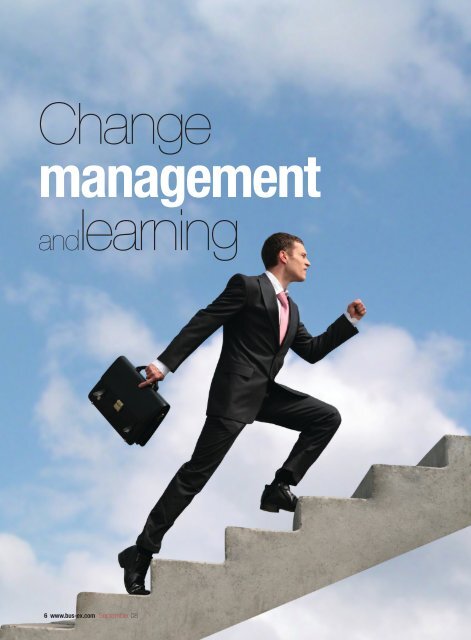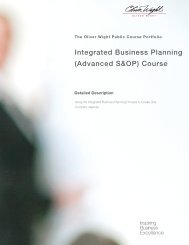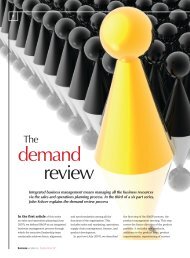Change Management and Learning - Oliver Wight Americas
Change Management and Learning - Oliver Wight Americas
Change Management and Learning - Oliver Wight Americas
You also want an ePaper? Increase the reach of your titles
YUMPU automatically turns print PDFs into web optimized ePapers that Google loves.
<strong>Change</strong><br />
management<br />
<strong>and</strong>learning<br />
6 www.bus-ex.com September 08
S t r a t e g i c m a n a g e m e n t<br />
After developing a succinct vision, <strong>and</strong> designing an organizational structure that supports the<br />
vision <strong>and</strong> enables the implementation of the strategy, CEOs must prepare their organizations<br />
for the planned change <strong>and</strong> lead the transformation. Part three of a series on managing <strong>and</strong><br />
leading people by Jon Minerich, Principal, <strong>Oliver</strong> <strong>Wight</strong> <strong>Americas</strong>, Inc.<br />
As Mark Twain quipped many years<br />
ago, “You know, I’m all for progress.<br />
It’s change I object to.” This applies<br />
only too well in business. While most<br />
CEOs recognize the need for change<br />
to stay competitive, transforming an<br />
organization is one of the most difficult<br />
undertakings they face.<br />
As we learned in part one, Strategy<br />
<strong>and</strong> leadership, two “truths” of<br />
organizational change are:<br />
1. Employees will emulate the<br />
behaviors of their leaders.<br />
2. An organization will not change<br />
until its leaders do.<br />
It is clear, then, that managing<br />
change within an organization begins<br />
in the executive suite. In this third<br />
article in the Managing <strong>and</strong> Leading<br />
series, we focus on three key areas<br />
of change management <strong>and</strong> learning:<br />
the context for change in business;<br />
developing a learning organization<br />
as the foundation for change; <strong>and</strong> a<br />
simple change management model<br />
any company can follow to insure a<br />
successful transformation.<br />
Underst<strong>and</strong>ing the context for<br />
change<br />
There is a paradox in the life of any<br />
business. When companies are<br />
successful, no one advocates change.<br />
In fact, there’s usually very strong<br />
resistance to change among the<br />
executives because share price is<br />
moving up, bonuses are great, <strong>and</strong> it<br />
is easy to attract top talent. No one<br />
wants to “mess with success.”<br />
Conversely, when companies are<br />
failing, CEOs become desperate<br />
to implement change to improve<br />
business performance. Unfortunately,<br />
when implementing significant change<br />
under these conditions, the probability<br />
of success is low. Among the many<br />
reasons, it may be that top talent is<br />
leaving for opportunities elsewhere;<br />
money is scarce for projects that<br />
don’t bring immediate improvement<br />
to the bottom line; <strong>and</strong> management<br />
attention is typically short-term<br />
focused, attempting to keep the<br />
business from further deterioration.<br />
We have a serious message for<br />
CEOs, even though it may sound<br />
counterintuitive. The probability of<br />
successfully implementing change in<br />
your organization is greatest when the<br />
perceived need for change is the lowest.<br />
How does a CEO overcome the<br />
natural resistance to change in a<br />
successful company? By using the<br />
vision, strategies, <strong>and</strong> values (the<br />
company’s roadmap to the future)<br />
to create the compelling case for<br />
change. In addition, the best CEOs<br />
view change management as a core<br />
competency required for all leaders,<br />
from executives down to first-line<br />
supervisors. <strong>Change</strong> is viewed as a<br />
“way of life” in the best companies, <strong>and</strong><br />
all business improvement initiatives<br />
are viewed as change—to be effectively<br />
planned <strong>and</strong> managed.<br />
Our research finds the most<br />
successful CEOs are very conservative<br />
when it comes to implementing radical<br />
change in their organizations. They do<br />
not implement change for change’s<br />
sake. Instead, they take a very<br />
deliberate approach, insuring there<br />
is a clear, strategic case (tied to the<br />
company’s vision) before implementing<br />
major changes in their companies.<br />
They underst<strong>and</strong> that accomplishing<br />
significant change takes time<br />
because successfully implementing<br />
change requires changing behaviors<br />
throughout the organization. These<br />
executives also underst<strong>and</strong> the<br />
September 08 www.bus-ex.com 7
maturity level of their business, <strong>and</strong><br />
changes are carefully planned to take<br />
the organization step by step through<br />
each level of maturity (as defined in<br />
part two, Designing & Developing<br />
Your Organization).<br />
Before embarking on a path that<br />
will create significant change, many<br />
leading CEOs ask themselves, “is the<br />
case for change driven by our vision<br />
<strong>and</strong> strategies?”<br />
1. Does this change take us to the<br />
next Business Maturity Level, or are<br />
we attempting to skip levels with the<br />
associated, detrimental effects?<br />
2. Can we define the organizational<br />
behaviors needed to sustain the change<br />
after the change is implemented?<br />
3. Do we have the time, talent, <strong>and</strong><br />
resources to implement this change?<br />
Regardless of the change being<br />
implemented, successful CEOs<br />
focus on their people. Their goal is<br />
to have the business transformation<br />
as painless as possible for their<br />
workforce. One of the best ways to<br />
prepare the workforce for change is to<br />
develop a learning organization.<br />
Developing a learning organization<br />
There is an underlying truth about<br />
human behavior when it comes<br />
to change. <strong>Learning</strong> leads to<br />
underst<strong>and</strong>ing, <strong>and</strong> underst<strong>and</strong>ing<br />
leads to a commitment to change.<br />
The CEO, as a first step, should<br />
articulate the skills the workforce<br />
needs to have to achieve their vision<br />
<strong>and</strong> should communicate the need for<br />
continual learning by everyone in the<br />
organization. This is to enable their<br />
people, processes, <strong>and</strong> technology<br />
to be adaptable to meet the everchanging<br />
requirements <strong>and</strong> dem<strong>and</strong>s<br />
of the marketplace.<br />
An effective way to enable an<br />
organization to adapt is by continuously<br />
communicating the changing market<br />
dem<strong>and</strong>s to the workforce so they can<br />
underst<strong>and</strong> why change is necessary.<br />
Then they can adopt a philosophy of<br />
continual learning.<br />
Executives must commit to active<br />
<strong>and</strong> ongoing education <strong>and</strong> training<br />
programs that give employees the<br />
skills they need to meet these changing<br />
dem<strong>and</strong>s. These programs will show<br />
the employees how their new skills<br />
will enable them to compete in the<br />
changing business environment.<br />
Another essential element is<br />
communication. Business books<br />
<strong>and</strong> trade journals have discussed<br />
effective communication in great<br />
detail, but a few, critical points must<br />
be emphasized:<br />
1. All communication should be<br />
linked to the vision <strong>and</strong> describe where<br />
the change is taking the company.<br />
2. All communication should be<br />
blunt <strong>and</strong> realistic, describing the<br />
current business environment driving<br />
the change.<br />
3. All communication must be<br />
clear <strong>and</strong> simple. If a message<br />
cannot be stated in a few simple<br />
sentences, rethink the message.<br />
CEOs must realize their messages get<br />
diffused throughout the layers of the<br />
organization. The message received by<br />
the line worker may differ greatly from<br />
the original message sent by the CEO<br />
unless it is clear, simple, <strong>and</strong> formally<br />
communicated.<br />
4. A CEO cannot communicate<br />
his/her vision too often. In many<br />
companies, critical decision meetings<br />
always start with a simple reading of<br />
the company’s vision, strategies, <strong>and</strong><br />
values (the roadmap to the future).<br />
That way, all participants are informed<br />
that the behaviors <strong>and</strong> decisions<br />
demonstrated in the meeting must be<br />
aligned to the roadmap.<br />
Following the “Proven Path”<br />
success model<br />
An implementation model has been<br />
tested for over 30 years in a wide variety<br />
of industries, from small businesses to<br />
Fortune 500 corporations. It is simple <strong>and</strong><br />
effective. When followed, it will ensure a<br />
successful implementation of any major<br />
business initiative. The foundational<br />
elements of the “Proven Path” are shown<br />
in the diagram on the right.<br />
There are three main phases—<br />
Leadership, Development, <strong>and</strong><br />
Ownership—which we’ll briefly<br />
review:<br />
Phase 1: Leadership<br />
The Leadership phase is the most<br />
important <strong>and</strong> includes the following<br />
components:<br />
1. Quick business diagnostic,<br />
comparing current operations to best<br />
practices.<br />
2. Executive education to underst<strong>and</strong><br />
the scope of the diagnostic, the size of<br />
the gaps between current operations<br />
<strong>and</strong> best practices, <strong>and</strong> the value to<br />
their business if they close those gaps.<br />
3. Establishment of the proper<br />
sequence for closing the gaps, based<br />
on the competitive priorities of the<br />
business, as determined by the CEO<br />
<strong>and</strong> his/her reports.<br />
4. Definition <strong>and</strong> development of the<br />
business case for the planned change,<br />
budgeting appropriate resources<br />
<strong>and</strong> the creation of the appropriate<br />
implementation structure (executive<br />
steering committee, implementation<br />
team, etc.)<br />
There is an old saying: “Top<br />
management commitment without<br />
underst<strong>and</strong>ing is a liability!” A<br />
commitment to proceed should be made<br />
only after all of the steps shown under<br />
the Leadership phase of the Proven<br />
Path have been completed. This “go/<br />
no-go” decision, with a formal sign-off<br />
in writing by the CEO <strong>and</strong> leadership<br />
team, is critical to the success of the<br />
transformation initiative.<br />
Phase 2: Development<br />
The Development phase begins once<br />
the commitment has been made. In<br />
this phase, we create a team of change<br />
agents <strong>and</strong> in-house experts that<br />
does the actual work of the business<br />
transformation. This implementation<br />
8 www.bus-ex.com September 08
S t r a t e g i c m a n a g e m e n t<br />
© <strong>Oliver</strong> <strong>Wight</strong><br />
team should:<br />
1. Be made up of the company’s<br />
best people—people who have the<br />
respect of the entire organization<br />
because when the workforce is<br />
confronted with major changes to<br />
their environment, they expect the<br />
best <strong>and</strong> most knowledgeable people<br />
to lead them to success.<br />
2. Be thoroughly educated in best<br />
practices <strong>and</strong> all of the steps defined in<br />
the Leadership phase, before the team<br />
begins the process of redesigning key<br />
business processes to close the gaps.<br />
3. Pay close attention to the<br />
integration of people <strong>and</strong> expected<br />
organizational behaviors, business<br />
processes, <strong>and</strong> the supporting<br />
technology necessary to implement<br />
the new business processes.<br />
Phase 3: Ownership<br />
Ownership is the final phase <strong>and</strong> is<br />
where the changes are implemented,<br />
<strong>and</strong> the benefits from making the<br />
changes are realized. Through a<br />
program of cascade education, all<br />
employees begin to underst<strong>and</strong> the<br />
new business practices <strong>and</strong> behaviors<br />
needed to transform the company.<br />
The education program must:<br />
1. Demonstrate, in digestible<br />
portions, how employees will work in<br />
their new business environment.<br />
2. Include a broad underst<strong>and</strong>ing of<br />
how the company will operate.<br />
3. Identify process changes <strong>and</strong> the<br />
behavioral changes associated with<br />
the same.<br />
4. Clearly communicate specific<br />
roles <strong>and</strong> responsibilities.<br />
Our recommendation is that<br />
technology or systems training should<br />
follow after the process <strong>and</strong> behavioral<br />
training is completed—it should never<br />
be before!<br />
It is crucial that the implementation<br />
team <strong>and</strong> business process owners<br />
conduct the majority of the cascade<br />
education. After all, they are the<br />
change agents, <strong>and</strong> by teaching, they<br />
are demonstrating:<br />
1. In-depth knowledge of the future<br />
state of the business.<br />
2. That the transformation is<br />
owned by the company leaders <strong>and</strong><br />
not some outside consultants, <strong>and</strong><br />
3. They are sending the message<br />
that the business process owners<br />
are accountable for sustaining<br />
the changes.<br />
During this phase, it is crucial that<br />
top executives look for <strong>and</strong> reinforce<br />
the changes in organizational<br />
behavior defined in the future design<br />
of the business.<br />
Conclusion<br />
Many CEOs attempt to change their<br />
companies either through a series<br />
of quick fixes or complex business<br />
models. History has demonstrated<br />
that most of these attempts fail or, at<br />
best, the benefits from these attempts<br />
are only temporary.<br />
All successful business<br />
transformations we have witnessed<br />
are based on a simple transformation<br />
model that focuses on the education<br />
<strong>and</strong> development of people <strong>and</strong> is tied<br />
to the company’s vision.<br />
I will always remember an old<br />
friend <strong>and</strong> mentor who taught me:<br />
“Things are easy to fix, people take<br />
time.” Invest in your people, <strong>and</strong><br />
you will be successful! Therefore, in<br />
Part four, Developing People, we will<br />
outline the challenges of creating<br />
your workforce of the future <strong>and</strong><br />
offer a number of effective solutions<br />
to help the CEO with this most<br />
important task.<br />
September 08 www.bus-ex.com 9

















